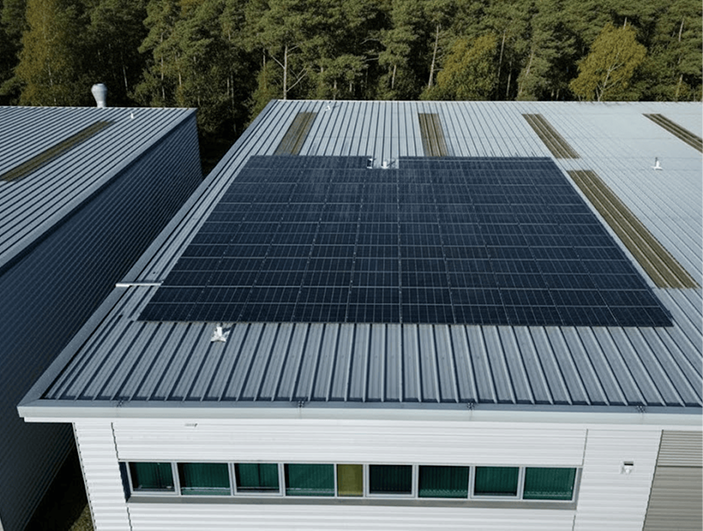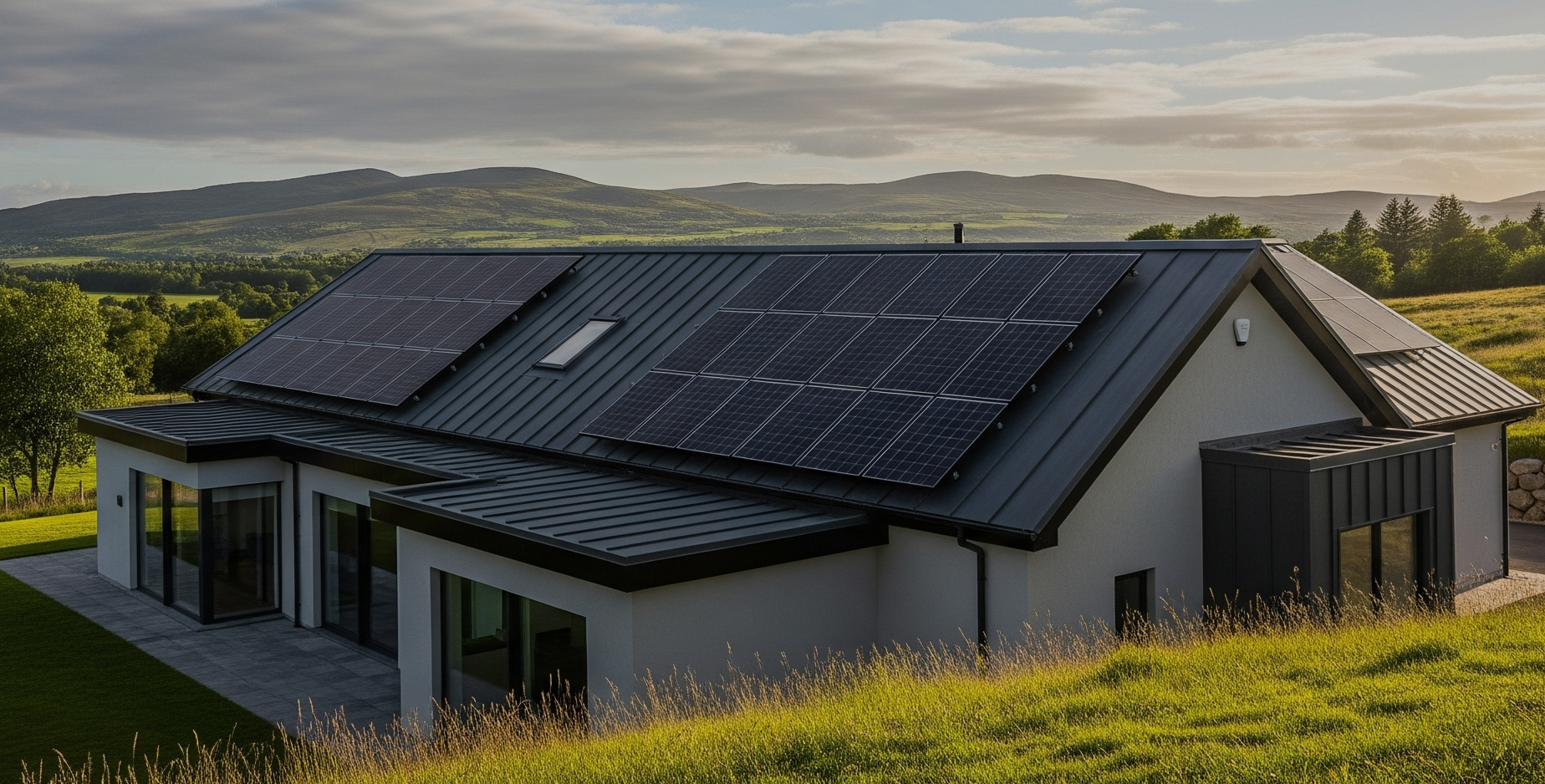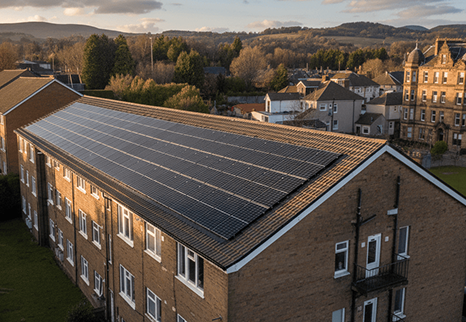Is Commercial Solar in Scotland Worth your Investment?
Straight-talking guide for Scottish businesses on commercial solar PV: DNO approvals (G98/G99), SSEN vs SPEN differences, export limiting, structural checks, finance, timelines, and payback.

Is Commercial Solar in Scotland Worth Your Investment?
You may have been looking into getting solar panels installed for your business and you're not the only one. Solar can be a good move and it seems everyone is doing it now with over 120,000 installations across the UK in the first half of 2025.
However, most of the growth has been domestic. The commercial process is definitely different. Specifically if you are in Scotland... There are things you should look into before going ahead with it. You don't want to be waiting 6 months later with no word from the DNO approval or your installer.
Quick Summary
Let's take a look and see what actually happens.
Are There Any Solar Grants for Commercial Solar PV?
If you've been searching online and have been seeing stuff about Home Energy Scotland grants, that's not for you, not for commercial solar anyway. From last year the grants are now focused on heat pumps, with it being for domestic stuff mostly. The government has decided that heat decarbonisation was the priority and... Solar's kind of on its own now.
There wasn't much grant money for businesses anyway. You're likely doing this because either your electricity bills are getting out of hand or you can claim capital allowances. That's it really, there are no grants or incentives, just basic economics, spend money now, save money over 20 years, get some tax relief. The tax relief is actually pretty good. We'll talk more on that in a minute.
One thing to note however Business Energy Scotland offers an SME Loan Scheme which is a government supported loan, not a grant but it's an interest free loan of up to £100,000 and can include a cashback component (up to a published cap that varies by measure and funding round). Solar PV is generally eligible however just check current cashback availability with Business Energy Scotland when you apply.
Three-Phase and That Annoying 16 Amp Thing
So most business premises run three-phase power. You've probably got machinery, big air con units, refrigeration etc. That's your 400V supply.
When you're putting solar in you want a three-phase inverter. This keeps everything balanced and the DNO and electricians happy.
But…..
There's this threshold at 16 amps per phase that changes everything. Anything below that you can use something called G98, this is where you install it then tell the network operator "hey, we did this." Nice and simple.
Over 16 amps per phase requires a G99. Which means you apply first and wait for approval, then install. The difference is often between a few weeks and a few months.
Here's the annoying bit though, 16 amps at 230V is only 3.68 kW. Per phase. So even a small three-phase system, like 15 or 20 kW total puts you over the limit. This puts it in the G99 category. On three-phase G98 effectively tops out at around 11.04 kW total which is a 3.68 kW per phase. Anything bigger than this is for G99.
Even small businesses would think 4 kW inverters would be small enough to skip the hassle but 4,000 watts divided by 230 volts is…. what, about 17.4 amps over the limit. So you'd have to go down the G99 route anyway.
So it's probably best to assume that you'd be going down the G99 route from day one.
SSEN or SPEN. It Actually Matters Where You Are.
This part is important.
Scotland has two main network operators. If your business is located in the north of Scotland and islands then you'd be dealing with SSEN. If you are in the central belt and south of Scotland, Glasgow, Edinburgh, that kind of thing then it's SP Energy Networks that you're with.
They both follow the same G99 rule which were most recently updated with ENA EREC G99 Issue 2 published on 10 March 2025. However, the way that they process the applications are different. The forms and time scales are different.
SSEN has something called Fast Track which sounds good on paper as it's 10 working days for a decision however the reality is that this is only if your application is perfect and you've submitted all the required evidence like your phase-to-neutral loop impedance and a clear schematic. If anything is wrong then you're likely to wait even longer. Fast Track/SGI comes in categories: SGI-1 is up to 16 A per phase, SGI-2 is up to 32 A per phase with export capped to 16 A, and SGI-3 is up to 60 A per phase with export capped to 32 A. It's not a shortcut for bigger installs, it's just a quicker route if you tick every box.
Imagine a facilities manager thinking everything is fine and submitting to SSEN then getting an email saying "we need your phase to neutral impedance readings" and not having them. This then means getting an electrician out and another week passes then re submitting etc. You can see the frustration if it isn't done right.
SPEN's is a bit different. They are more upfront about fees and potential problems. They'll tell you how it is "even if you limit your export, we might still need to upgrade cables in your area." At least you know where you stand with them.
They also like to use witnesses a lot. If you are limiting export they might send someone out to check that your settings are actually locked in properly. This costs money, but again at least they warn you. You should budget for possible witnessed testing and admin fees with SPEN if you're using export limiting.
Export Limiting. This Is The Big One
This is the thing that changes most commercial projects and nobody sees coming.
Scotland's got a lot of old electricity networks, especially rural areas. Cables from the 70s that were sized for like three farms and a village. When you start pumping solar power back into those cables on a sunny day the voltage goes up. If it's too high everything downstream starts having problems.
So the DNO says "you can connect, but you have to limit your export to X amount."
Usually it's 3.68 kW per phase or sometimes less. It has to be enforced by a G100‑compliant export‑limiting device, and under EREC G100 Issue 2 the export limitation must be fail-safe and hold export at or below your Agreed Export Capacity within 5 seconds. Some DNOs including SPEN will want to witness the commissioning of the export limiter and will charge you a fee for it.
Your inverter gets programmed so it physically can't export more than that. Anything you generate that you're not using yourself either gets curtailed (inverter turns down) or dumped into a battery if you've got one.
Now. Does this kill the project? Not necessarily it depends on your usage.
Here's an example. Take a warehouse, cold storage, conveyors running all day. Their electricity bill say is around £2,200 a month. This could work out say that they use about 70% of what they'd generate during daytime. The export limit would mean something like they'd only be able to sell maybe £200 worth of surplus a year instead of £600.
Is that ideal? Not really but they're still saving over £15,000 a year on their actual usage. The export was always just a bonus.
If you're a business that only operates nights, or you barely use power during the day...then, yeah, export limiting's going to hurt. But if you've got decent daytime load e.g. machinery, lighting, refrigeration, whatever then you're probably fine. You just need to model it properly.
The worst thing is when someone sells you a system promising £1,000 a year in export payments and then the DNO comes back with export limiting and suddenly those numbers don't work anymore. That's why you apply to the DNO before you commit to anything. Get the connection offer in writing.
Scottish Roofs Are Different And Not In A Good Way
You can't just stick solar panels on a Scottish industrial roof and hope for the best. The wind loading here is significant. Solar panels don't sit snugly in the roof; they are sat on top and can catch high winds so it's vital that the solar installation is designed to deal with worst of our Scottish weather and you check the wind loading properly at the start. The design needs to be to BS EN 1991-1-4 for wind and BS EN 1991-1-3 for snow with the UK National Annex. Many Scottish sites have higher wind exposure, especially west coast and islands, so uplift checks and ballast or fixing design must reflect local loading. You need a structural engineer who understands this stuff and doesn't just copy and paste from a standard detail.
Flat roofs are different, they have ballasted systems which are easier and require no drilling but they're heavy. You've got to check that the roof can handle it, and you can't block drainage.
If your building's from the 70s or 80s there's a decent chance that they have got asbestos cement sheets. You cannot drill those, If you do, you're looking at HSE issues. At that point you're either standing off with a separate frame or you're re-roofing first.
Asbestos Warning
If your building's from the 70s or 80s there's a decent chance that they have got asbestos cement sheets. You cannot drill those. If you do, you're looking at HSE issues. At that point you're either standing off with a separate frame or you're re-roofing first.
Most rooftop commercial PV in Scotland is permitted development, but listed buildings, conservation areas, or structural alterations can trigger planning permission or a building warrant so it's worth checking early with the local authority.
Just... get the structural survey done early before you sign anything.
Money. Where The Tax Part Actually Good
So… as I said earlier financial side has no grants but capital allowances are pretty decent for businesses.
Annual Investment Allowance (AIA) lets you write off up to 1 million pound of equipment each year against your profits which include Solar PV. So if you spend £50,000 on a solar system and you claim £50,000 AIA then your taxable profit drops by £50,000. At 25% corporation tax? You'd be saving £12,500 in tax. It means effectively your cost is £37,500 not £50,000.
Typical Costs
Example based on £50,000 system with full AIA claim at 25% corporation tax. VAT is 20% for commercial (reclaimable if VAT registered). Always consult your accountant.
There's also something called full expensing for certain plant but you're best talking to your accountant because the rules around what's plant versus what's a fixture do my head in. Best to just raise it with them.
For VAT though, commercial PV is standard-rated at 20%. The 0% VAT relief applies to domestic installations only. If you're VAT registered you can typically reclaim the VAT so it's a cashflow point rather than a net cost, but you need to have that 20% upfront.
SEG Isn't Going To Make You Rich
Smart Export Guarantee is where you sell your surplus energy back to the supplier. SEG is available for installations up to 5 MW provided you meet supplier criteria like having an export meter and MCS or equivalent evidence, which covers pretty much everything commercial. Rates vary with some suppliers paying 4p per kWh and some pay 15p, it just depends on if it is fixed, variable, time of use or whatever.
Unless you're exporting loads, it might not be worth the money to be honest. A 30 kW system exporting say 30% of what it generates (because the rest you'd be using on site) at 8p per unit is like £300 a year. It's nice but as I said, it's not going to make you rich. The real value is in what you are not importing. 20p, 25p, 30p per kWh for grid electricity and you're generating it yourself instead, this is more where the money is.
You may be thinking about if you should size your solar panel system to be much larger that your daytime needs with a goal of maximising your export income. Whilst this is possible, it's not often the best financial strategy due to export limiting from the grid and relatively low SEG rates. This approach is like building a wee unprofitable power station. The best financial return comes from sizing the system to what your business uses during the day, offsetting the need to buy expensive electricity from the grid.
How Long Does All This Take?
To be honest, it does take longer than you'd want. A straightforward under 50 kW system on a decent building with no dramas is usually about 4 to 6 months from initiation to being switched on.
Typical Costs
Even small 25 kW systems can face delays extending timelines beyond 7 months. You need patience and someone managing it who knows what they're doing.
The design and quote usually take a couple of weeks. Standard G99 decisions often land in 4 to 8 weeks if it's straightforward, but you should allow 4 to 12 weeks if there's any back and forth or queries.
The install itself takes maybe a week or two, it just depends on the weather and the roof complexity. Then commissioning, getting your export metre sorted, waiting for the MPAN (the metre point number for export) is probably at least another month. Your supplier has to create the export MPAN and may need to reconfigure or replace the metre, both can add a few weeks.
If you are over 50 kW or in an area that has grid constraints then you're typically looking at longer studies and this could add on another quarter, maybe more.
Even relatively small installation such as 25 kW system can have significant delays which can sometimes extend the project timeline to more than seven months. It's not fast and you need patience and someone managing it who knows what they're doing and will chase people.
Is It Worth It Though?
It depends really. If you're spending decent money on electricity during the day for example £1,500, £2,000 a month or more and you've got roof space that's not shaded or falling apart then probably yeah.
Payback normally takes 5 to 7 years for a decent commercial system once you factor in the capital allowances, without the AIA it'd be more like 8 or 9 years. Then you've got 20, 25 years of cheaper electricity after that and protection against price rises, which let's be honest, they're only going one direction.
But you need the right building. Warehouses are great with daytime operation, decent loads. Light industrial with machinery is perfect. Farms with cold stores and dairies great too.
However, stuff that only operates evenings wouldn't be a great investment. Anything with a tiny roof or little sun exposure would be pointless. Old buildings that can't structurally handle the weight is a whole feasibility study before you even start.
You need someone who'll walk the roof, check the structure, model your actual usage pattern and be straight with you if it's marginal and make sure they've done G99 applications with your DNO before. I've seen sparkies who are brilliant at domestic G98 installs absolutely flounder when they hit their first SSEN application, it's a different world.
Get someone who knows the process and who'll get your structural stuff sorted upfront ensure that they put realistic generation numbers in and not just best case, and make sure there are realistic export assumptions (assume you'll be limited). Then you'll know if it's worth it or not.
Need Help Figuring Out If Commercial Solar Is Right for Your Business?
We work with businesses across Scotland and can walk you through the real numbers, the good and the bad. From DNO applications to structural surveys, we handle the entire process with realistic projections and straight talk.
Frequently Asked Questions About Commercial Solar in Scotland
Common questions about commercial solar PV installations for Scottish businesses, covering DNO approvals, export limiting, grants, and payback periods.
Mackie Electrical - NICEIC-approved electrical contractors serving Central Scotland. Specialists in commercial solar PV installations, G99 DNO applications, and commercial electrical services for businesses in Stirling, Perth, Falkirk, Glasgow, and throughout Scotland.
Related Articles
Continue reading with these similar topics

Octopus Flux vs Go vs Intelligent Go in Scotland (2025): Best Pairings for Solar, Batteries and EVs
Flux vs Go vs Intelligent Go in Scotland (2025): which Octopus tariff suits solar, batteries and EVs? See Scottish rates, example schedules and settings.

The Ultimate Guide to Solar Panel Installation in Scotland 2025
Your complete 2025 guide to solar panels in Scotland. Learn about installation costs, grants like Home Energy Scotland, ROI, and the step-by-step process.

What's Possible with Solar Panels for Flats and Tenements in Scotland
Complete guide to installing solar panels on flats and tenements in Scotland. Learn about ownership, consent requirements, SolShare systems, costs, grants, and how to get your neighbours on board.